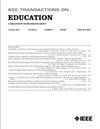电子与计算机工程学院教师采用循证教学实践的环境影响因素
IF 2.1
2区 工程技术
Q2 EDUCATION, SCIENTIFIC DISCIPLINES
引用次数: 0
摘要
贡献:本研究旨在进一步了解电子与计算机工程(ECE)专业教师在采用循证教学实践(EBIP)时所面临的基于情境的负担和障碍。研究采用定性分析的方法记录了基于情境的影响因素,包括影响六位幼教专业教师采用循证教学实践的动机、限制因素和反馈机制。背景:最近的工程教育文献指出,尽管工程学院教师对 EBIPs 的认识、对其有效性的信念以及对整合 EBIPs 的兴趣都有所提高,但工程学院教师对 EBIPs 的采用仍然滞后。尽管研究人员继续调查科学、技术、工程和数学教育环境中教师采用 EBIPs 的障碍,但很少有研究专门针对特定学科背景进行考察,尤其是在幼教教师中。研究问题哪些基于情境的障碍和可承受性会影响幼儿教育教师采用幼儿教育综合方案?研究方法:本研究对来自美国各地工程专业的六位幼教教员的深入访谈数据进行了定性分析。研究采用了案例研究和主题分析相结合的迭代技术,以确定与每位参与者相关的背景因素和独特因素,并从系统的角度综合分析在采用 EBIPs 时的决策过程。研究结果:总体而言,该方法确定了四类采用 EBIP 案例的驱动因素、制约因素和反馈机制:1) 未使用;2) 停止使用;3) 开发中;4) 继续使用。研究报告举例说明了六位参与者在采用 EBIP 的程度方面受到的基于环境的影响,强调了教师在采用 EBIP 方面的经验存在很大差异。本文章由计算机程序翻译,如有差异,请以英文原文为准。
Contextual Influences on the Adoption of Evidence-Based Instructional Practices by Electrical and Computer Engineering Faculty
Contribution: This study aimed to improve understanding of context-based affordances and barriers to adoption of evidence-based instructional practices (EBIPs) among faculty in electrical and computer engineering (ECE). Context-based influences, including motives, constraints, and feedback mechanisms impacting EBIP adoption across six ECE faculty participants were documented using qualitative analysis. Background: Recent engineering education literature notes that the adoption of EBIPs by engineering faculty is lagging despite increased faculty awareness of EBIPs, belief in their effectiveness, and interest in integrating them. While researchers continue to investigate barriers to faculty adoption of EBIPs in science, technology, engineering, and mathematics education settings, few studies have dedicated examinations within a specific disciplinary context, particularly among ECE faculty members. Research Question: What context-based barriers and affordances influence adoption of EBIPs by ECE faculty members? Methodology: This study qualitatively analyzed data from in-depth interviews with six ECE faculty members from engineering programs throughout the United States. The study applied an iterative combination of case study and thematic analysis techniques to identify context-relevant and unique factors relevant to each individual participant and synthesize the process of decision making when incorporating EBIPs using a systems perspective. Findings: Overall, the approach identified drivers, constraints, and feedback mechanisms in regard to four emergent categories of EBIP adoption cases: 1) no use; 2) discontinued use; 3) in development; and 4) continued use. The study reports examples of context-based influences among the six participants in relation to their level of EBIP adoption, highlighting the substantial variation in faculty experiences with incorporating EBIPs.
求助全文
通过发布文献求助,成功后即可免费获取论文全文。
去求助
来源期刊

IEEE Transactions on Education
工程技术-工程:电子与电气
CiteScore
5.80
自引率
7.70%
发文量
90
审稿时长
1 months
期刊介绍:
The IEEE Transactions on Education (ToE) publishes significant and original scholarly contributions to education in electrical and electronics engineering, computer engineering, computer science, and other fields within the scope of interest of IEEE. Contributions must address discovery, integration, and/or application of knowledge in education in these fields. Articles must support contributions and assertions with compelling evidence and provide explicit, transparent descriptions of the processes through which the evidence is collected, analyzed, and interpreted. While characteristics of compelling evidence cannot be described to address every conceivable situation, generally assessment of the work being reported must go beyond student self-report and attitudinal data.
 求助内容:
求助内容: 应助结果提醒方式:
应助结果提醒方式:


